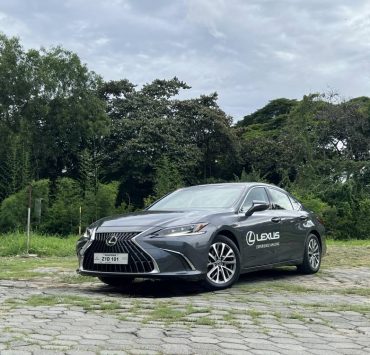Toyota’s top scientist lays down 1:6:90 rule

Toyota Motor Corp’s go-to guy in the science of automotive technology goes by the name of Gill A. Pratt.
No, I wasn’t able to ask him if he was, in any way, related to Chris Pratt of the “Guardians of the Galaxy” fame. But in any case, Gill is a celebrity in his own right, being the chief scientist and executive fellow for Research of Toyota Motor Corp and the CEO of Toyota Research Institute Inc. That means, he knows the secrets to the company’s own “infinity stones,” the mile markers for the Japanese carmaker’s multi-pathway approach to its automotive future.

Pratt—an MIT-educated scientist who wowed the scientific community with his invention of electric series-elastic actuators used for bipedal “dinosaur” robots—was formerly from the Robotics Challenge of the Defense Advanced Research Projects Agency (Darpa), a research and development agency of the United States Department of Defense. Pratt said that Darpa was created in response to the launch of the Sputnik. He worked on robotics and neuromorphic computing, making machines that could help in disasters and making computers that worked like a brain.
The carmaker’s way forward is encapsulated in Pratt’s interesting ratio, 1:6:90, in as far as carbon dioxide emissions reduction goes.
He explains, “How do we actually get to net zero? 1:6:90 means that if we take a certain amount of lithium to make one long-range battery electric vehicle (BEV), we can use that same amount of lithium to make 6 plug-in hybrid vehicles (PHEVs) because the batteries on those cars are much smaller. And because we have 6 of them, even though each one doesn’t save as much carbon dioxide as the one BEV, it turns out that we can save five times as much CO2 as the one BEV. And if we’re going to look further, we can make 90 hybrid electric vehicles (HEVs) because the batteries in those are much, much smaller for the same total amount of lithium, and there, again, they don’t save as much carbon dioxide as the PHEVs or the BEVs do but we can save up to 45 times as much with the same amount of lithium versus that one BEV,” he said.
Pratt added that if lithium is in short supply, then instead of only making BEVs, it makes sense to make a mixture of all three different types, with BEVs used in parts of the world where there are a lot of renewable power, and in the other parts where the renewable power is not so good, the other types of vehicles could be used.
What sorcery is this? When you think about it, that ratio does make a lot of sense, given that, over the years, the supply of lithium, the mineral needed to make batteries for EVs and other consumer electronics goods, has often been called into question. In science writer Seth Fletcher’s book “Bottled Lightning Super Batteries, Electric Cars and the New Lithium Economy,” he mused that if the world traded in lithium instead of oil, what would stop those countries with rich lithium resources from arbitrarily raising their prices. “So we go from OPEC to LiPEC? Or the Organization of Lithium Exporting Countries–OLEC?” Fletcher quipped.
As far back as 18 years, there was a lithium supply debate brewing. The argument was that an electric car revival using lithium-ion battery was nothing but a headlong rush into dependence on yet another finite source, an addiction to oil traded for an addiction to lithium.
For context, Fletcher, when he wrote about the lithium debate, came from the second annual Lithium Supply and Markets conference looking for the truth behind the lithium supply debate. Fletcher wrote that plenty of credible people had also been expressing unease about the reliability of world lithium supplies. He cited Donald Sadoway (an MIT electrochemist), whom he described as a “proud ambassador for electrochemistry,” had soured on lithium because of such concerns. He quoted Sadoway saying: “I started asking, how much lithium is there on the planet that’s readily available? Where are the decent lithium resources?” Fletcher said that they’re in surface brines on the border between Bolivia and Chile and in China. So that’s when Fletcher started asking: “Are we going to trade in importation of petroleum, for importation of lithium?”
Again, for context, here’s an excerpt from science and technology journalist Hilary Lamb (who studied physics in University of Bristol and science communication at Imperial College) and medical and science writer Bea Perks, a journalist based in Cambridge UK with a PhD in clinical pharmacology. They collaborated on the book “Simply Emerging Technology.”
“There are many challenges in making EVs that can compete with their conventional counterparts, the main one being that fossil fuels are far more energy dense (that is, they provide more energy relative to their volume) than even the best lithium-ion batteries. Engineers are working to optimize EVs to ensure that they can perform as well as fossil fuel-powered cars.”
Lamb and Perks also weigh in on the main challenge sustainable batteries must hurdle. “Much more battery capacity will be required to support the phase-out of fossil fuels from the energy sector. Lithium-ion batteries are the most common energy-dense batteries, but they require rare earth metals.”
The book points out that researchers are hard at work developing batteries from different materials that perform as well as, or better than, lithium-ion batteries. Lamb and Perks cited the alternatives such as saltwater batteries, which primarily conduct electricity with sodium ions and have the potential to be safe, sustainable, and recyclable. Saltwater batteries carry no fire risk. The absence of heavy metals makes saltwater batteries easy to recycle. They have longer life cycles than traditional lithium ones. Other options include sodium-ion batteries, solid state batteries (which have solid electrolytes), and molten-salt batteries (which have salt electrolytes).
But until then, lithium would be the main mineral component of EV batteries, and its global price as a commodity will still be dictated upon by the law of supply and demand, according to Pratt. And just like any commodity, its prices are constantly fluctuating. He added that, looking at the long-term, there will be an incredible discrepancy between the need and the supply that’s expected even in the most optimistic case for new mines being set up. To prove his point, Pratt showed industry projections from forecasting leader Benchmark Mineral Intelligence.
“We still have a resource limitation for lithium that’s going to create a need for this 1:6:90 rule. More generally speaking, lithium is not the only resource that is limited. So, our real problem is that we need to stop wishful thinking. We need to stop imagining ‘but what if everybody did this? What if everybody just does that? What if there were no resource limitations whatsoever?’ This is what wishful thinking does,” Pratt said.
I think Pratt’s “1:6:90” rule for BEVs, PHEVs and HEVs, could provide some insight as to how the world could avoid another global dictatorship of the next most in-demand finite resource. This certainly deserves a closer look from all stakeholders, meaning all of us who depend, one way or another, on transport for our daily survival and growth.

















